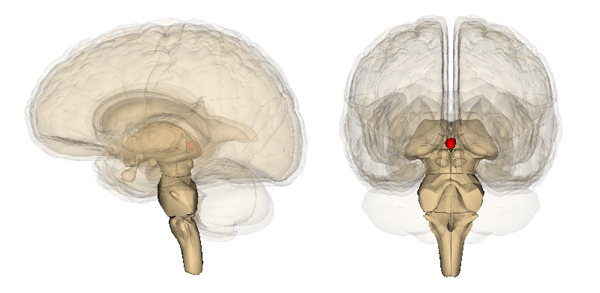NIH findings provide basic information in search for treatments of jet lag, seasonal disorder

The brain’s pineal gland has two kinds of pinealocytes—cells that make melatonin—the hormone that regulates the body’s sleep and wake cycles, according to a rodent study conducted by researchers at the National Institutes of Health. The first type, which accounts for about 5 percent of the overall pinealocyte population, appears to produce much greater amounts of melatonin than the second type, which is more abundant. The findings have the potential to inform future research on disorders that involve melatonin, such as jet lag and seasonal affective disorder. The study, appearing in PLOS One.
Background
Melatonin production rises in the evening and falls in the morning. Melatonin dietary supplements have been studied for sleep disorders and as a treatment for sleep problems in people who work night shifts.
To learn more about the cells that comprise the pineal gland and the substances they produce, senior author David Klein, Ph.D., Scientist Emeritus at NIH’s Eunice Kennedy Shriver National Institute of Child Health and Human Development and colleagues at the National Institute on Deafness and other Communication Disorders and University of Copenhagen, Denmark, analyzed messenger RNA—a molecule produced by cells that is instrumental in translating the instructions contained within DNA into proteins.
Results
The less-abundant alpha pinealocytes appear to have a high capacity to make melatonin. Compared to the more abundant beta pinealocytes, the alpha cells could make twice as much adenosine triphosphate, which is critical for manufacturing melatonin. Similarly, the alpha cells had twice the level of an enzyme that also plays an important role in making melatonin.
Significance
The different functions of alpha and beta pinealcytes suggests that drugs could be targeted to each cell type to develop potential treatments for disorders involving melatonin.
Reference
Mays, JC, Kelly, MC, Coon, SL, Holtzclaw, L, Rath, MF, Kelley MW, and Klein, DC. Single-cell sequencing of the mammalian pineal gland identifies two pinealocyte subtypes and cell type-specific daily patterns of gene expression. PLOS One 2018. https://doi.org/10.1371/journal.pone.0205883

 BACK TO TOP
BACK TO TOP